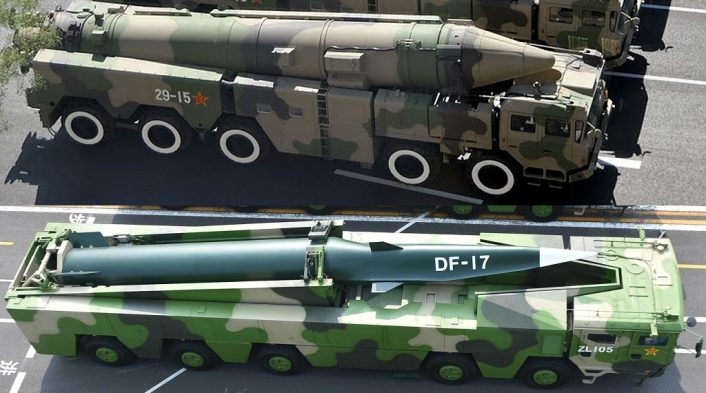The missile could be a variant of the DF-21 “Carrier Killer” Anti-Ship Ballistic Missile or of the DF-17/DF-ZF Hypersonic Glide Vehicle.
A few days ago, a video was posted on Twitter showing a Chinese H-6N bomber with what seems to be an Air Launched Ballistic Missile (ALBM) underneath the fuselage during landing at an unspecified airbase. This is the first time the aircraft was seen carrying this type of weapon since its entry into service last year.
The People’s Liberation Army Air Force‘s Xian H-6N bomber, developed from the H-6K which is in turn a derivative of the Soviet Tu-16 Badger, was specifically designed as a ballistic missile launcher, with the first reports about this mission surfacing in 2017. The most visible difference from the earlier model is the lack of the bomb bay which has been replaced by a semi-recessed area with attachment points for a large weapon. Another difference is the presence of an aerial refueling probe, which was missing on previous versions of the aircraft.
— OedoSoldier (@OedoSoldier) October 17, 2020
The primary weapon of the H-6N, according to available info, should be the CH-AS-X-13, also known as DF-21D, the air launched version of the DF-21 “Carrier Killer” Anti-Ship Ballistic Missile (AShBM), reportedly with a range of 1450 km (780 NM), Mach 6 speed (some sources state even Mach-10) and a 600 kg (about 1300 lbs) payload. This weapon should be the same that was carried by the bomber in the video, as reported by Andreas Rupprecht, renowned expert about Chinese military aviation.
For the first time a H-6N was seen landing with an air-launched Anti-ship ballistic missile (ALBM/AShBM). This missile so far labelled as CH-AS-X-13 is often referred to the DF-21D but here it looks almost to feature an DF-17 like hypersonic glide vehicle (HGV) on top the rocket pic.twitter.com/yOugsjkkhx
— @Rupprecht_A (@RupprechtDeino) October 17, 2020
The first reports about the existence of the DF-21D in 2010 sparked some concerns as Pentagon officials stated that, if the claims about the missile’s capabilities are true, the United States may not have a defense against it, as the maneuverable re-entry vehicle (MaRV) and the high speed could complicate the interception by air defense weapons. This led the U.S. Navy to potentiate the Aegis Ballistic Missile Defense System aboard ships in the Pacific Ocean while new advanced systems are developed. China reportedly test-fired two AShBM in the South China Sea in late August, one of them being a DF-21D.
The grainy images from the video do not allow a precise identification of the missile however, as both Rupprecht and The Warzone noted, the top of the missile resemble the DF-ZF Hypersonic Glide Vehicle of the DF-17 ballistic missile. The existence of this missile was first confirmed in 2014, with a range between 1800 and 2500 km and speed of Mach 5 (10 during the glide phase of the DF-ZF). If this hypothesis is confirmed, it could be considered as a Chinese response to the U.S. hypersonic weapons development like the AGM-183 ARRW.

The only way to know for sure is to wait for new higher quality videos of photos, if any, considered that the H-6N bomber seems to be very secretive. The aircraft disappeared from the public scenes after their participation in the 70th National Anniversary military parade in 2019, when three bombers with serials 55301, 55302 and 55034 were seen for the first time.
The serials were reportedly not associated with any PLAAF bomber unit. Recent renovation works at Neixiang Airfield in the Henan province with features compatible with large aircraft like the H-6N suggested that this could be the bomber’s new home. The mysterious units who operates them seems to be a former bomber unit reactivated last year, the 106th Brigade.
The video has been geo-located near the northern end of the runway of Neixiang Airfield, confirming that the H-6N may indeed be based there.
The video footage of an H-6N with a possible air-launched ballistic missile appears to be taken at this location just outside Neixiang Afld. This corroborates my theory that the 106th bde operates H-6N’s and, per the CMPR suggesting nuclear-capable ALBMs, is a nuclear unit. https://t.co/aJtOw9PzmD pic.twitter.com/Y4KXN9MldV
— Rod Lee (@roderick_s_lee) October 17, 2020









